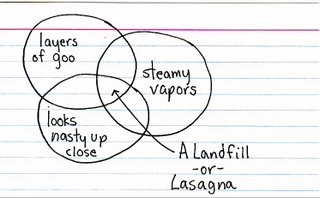
Thinking differently

By continuing your visit to this site, you accept the use of cookies. These ensure the smooth running of our services. Learn more.

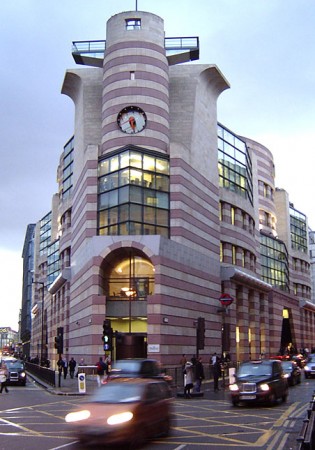
A quick trip to London's Number 1 Poultry today. If you can get to the impressive roof garden there are stunning views that more than make up for the irksomely courageous whimsy of the controversial architecture.
Peter Palumbo spent decades acquiring the site site piecemeal from 1958. His scheme to demolish the listed Mappin & Webb building and replace it with what Prince Charles called a 'giant glass stump' - a monumentally impressive bronze coloured steel and glass tower by Mies van der Rohe - was decisively thrown out in 1984.
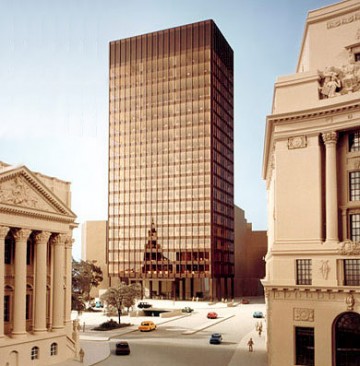
Palumbo's answer to his critics was to appoint RIBA medal-winner James Stirling to design a vigorously jokey post-modernist block.
Stirling thought he had only a 50-50 chance of success. "I do regard this site as being very special, at this spider's web intersection surrounded by all those heroes like Lutyens and Hawksmoor and Dance. It's the quintessence of London."

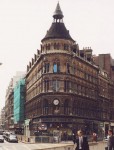 Like a stranded submarine decked out in pink stripes, the triangular building seems desperately to be sailing its giant conning tower up the slope towards the Mansion House. The stepped frontage ripples with fiddly bits. Triangles are punched out of the facade and theatrical games are played with circles and squares. The building has a bunker-like rear that currently accommodates a Wetherspoons.
Like a stranded submarine decked out in pink stripes, the triangular building seems desperately to be sailing its giant conning tower up the slope towards the Mansion House. The stepped frontage ripples with fiddly bits. Triangles are punched out of the facade and theatrical games are played with circles and squares. The building has a bunker-like rear that currently accommodates a Wetherspoons.
But it uses Portland stone and granite, and it contains echoes of the old buildings on site (if anyone remembers them) so it could hardly upset the purists, could it? Could it ever. Prince Charles demonstrated his familiarity with the latest technology when he said it looked like a 'broken 1930s wireless set'.
Delayed by recession, the design was posthumously completed after Stirling died at the hands of an incompetent anaesthetist. Since then it has regularly won polls for both the best and worst building in London.
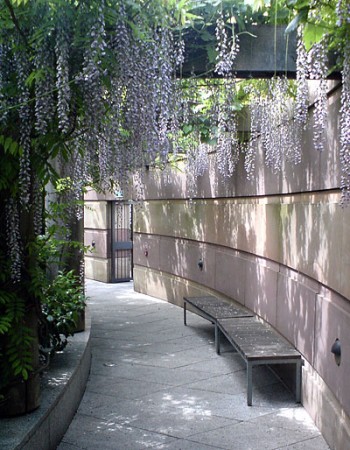 Walk into the open rotunda at the centre of the development (with its irritating Dayglo coloured window casements) and take the lift to the Conran-run 'Coq d'Argent' roof garden restaurant and a whole new impression forms.
Walk into the open rotunda at the centre of the development (with its irritating Dayglo coloured window casements) and take the lift to the Conran-run 'Coq d'Argent' roof garden restaurant and a whole new impression forms.
Wisteria and hawthorn flourish. Fragrant box hedging leads to stunning views of the gherkin and Wren City churches from the glass ship's bridge, either side of the conning tower. Well worth a visit, especially on a Sunday when the people paid to keep rubber-neckers away from the rooftop are less likely to be on duty.
New Zealand company The Conch's 'Vula' was simply one of the most magical evenings I've ever experienced in the theatre. Four women brought the South Seas to sparkling life in the subterranean darkness of the Barbican's Pit Theatre. They performed on a beautifully lit flooded stage - singing, dancing and acting out stories of the sea and everyday life beside it.
Passionate, funny and totally involving tales of church-going, washing clothes, goddesses and fishes, told by four strong, proud and beautiful women. A Fijian audience member wearing a hibiscus flower dress was so moved she couldn't help singing along with the songs and whooping with joy as each new scene unfolded. In the finale a tiny outrigger boat is sung to safe harbour. In any other show it might be a cliché but in Vula it was completely bewitching.
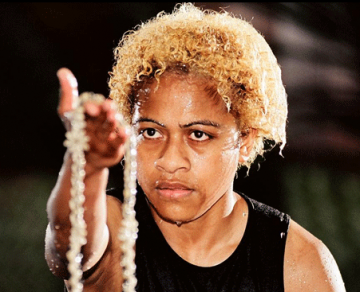
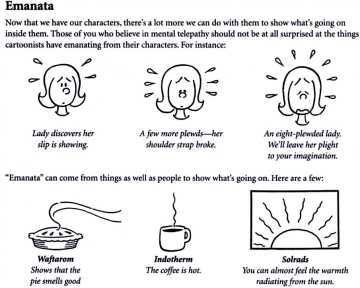
Don't know a grawlix from a plewd or an agitron from an indotherm? Finding words for the marks made by cartoonists is a funny business. A jokey article about the marks cartoonists make for things like movement, emotion and radiation is now the stuff of earnest research into the visual language of cartoons.
It seems to have started with American cartoonist Mort Walker who wrote a satirical article in 1964 called "Let's Get Down to Grawlixes," for the National Cartoonists Society. In 1980 he expanded it to a book The lexicon of comicana. In Mort Walker's Private Scrapbook he writes:
'I spoofed the tricks cartoonists used, like dust clouds when characters are running or lightbulbs over their heads when they get an idea... I spent many hours at the museum recording their "language". I created pseudoscientific names for each cartoon cliché, like the sweat marks cartoon characters radiate. I called them "plewds" after the God of rain "Joe Pluvius".'
The spoof didn't quite work (even though the words he invented are very funny), because people really wanted words for the marks cartoonists make. So here is a run-down, from Wikipedia:
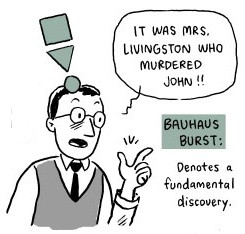 It's funny in a Sellars & Yeatman kind of way (something else that deserves to be better known). Dash Shaw responded to the comic challenge with a great cartoon strip using the symbols and The Balloonist drew a booklet for cartoonists using some new symbols. Needless to say, the academically minded take it all very seriously. Neil Cohn just about gets the point. But only just:
It's funny in a Sellars & Yeatman kind of way (something else that deserves to be better known). Dash Shaw responded to the comic challenge with a great cartoon strip using the symbols and The Balloonist drew a booklet for cartoonists using some new symbols. Needless to say, the academically minded take it all very seriously. Neil Cohn just about gets the point. But only just:
'He also attaches a myriad of useless names to them, to the extant that you feel that his whole point for jargon is to be facetious (which it may well have been).'
 See also an explanation of Kirby Dots (developed by Jack Kirby to show an energy explosion) and a site devoted to cataloguing onomatopoeia like 'kaboom' (apparently first used in The incredible hulk, vol 1, no. 229, 1978).
See also an explanation of Kirby Dots (developed by Jack Kirby to show an energy explosion) and a site devoted to cataloguing onomatopoeia like 'kaboom' (apparently first used in The incredible hulk, vol 1, no. 229, 1978).

There's much chortling that around a quarter of London's electorate decided to make 'bumbler' Boris their Mayor on St Boris's Day. But how has the blonde bombshell served his Henley constituents and what will they do without him?
In the Bulgarian Orthodox church at least, the anniversary of the death in 907 of St Boris is remembered. He was notable for his serenity, aside from a lapse in which he blinded his son to stop him turning to paganism. 'Serene' is not the word to describe Boris Johnson MP in Henley-on-Thames. Scarcely an issue of the local paper has been complete without two or even three photos of Boris pressing the local flesh. Opening this or standing against the closing of that, Boris has been there, even during the Mayoral campaign.
He responded twice to our lobbying on local causes. Once a local hotelier 'laid on a crayfish lunch' to woo him to our presentation of the need for a new bridge across the Thames between Reading and Henley. He watched our video of the 45min queue of standing traffic snaking round narrow village lanes, ate the crayfish sandwiches, and pronounced (fresh from his trip to a local marina) that the best answer to the problem of 13,000 vehicle movements a day choking a tiny village was to set up a ferry to carry passengers across the river.
This entertaining tendency to make it up on the hoof (remember his disastrous gaffes in Liverpool and elsewhere) conceals Boris's steely determination. At the post-electoral celebrations his sister commented that Boris has always got what he wanted.
Each time we met him Boris was surrounded by a group of local party faithful. Once or twice I caught them raising their eyebrows - 'Boris will be Boris' was the story. First Hezza represented us (another MP notable for his beazer), then Boris. So who will be next? Perhaps his father Stanley, who confirmed:
"Put it this way, I'm still on the candidates' list. Obviously it would be up to the Henley association as to whether they invite me for interview, but I don't see why I shouldn't put in for it."
He certainly has the requisite distinctive hairstyle.
The the nu-Labour project is on its last legs and Londoners have registered their protest at Gordon Brown's lack of personality. It remains to be seen if (in spite of his goodwill and determination) Boris really will be enough to reduce the death rate of young black men in the capital.